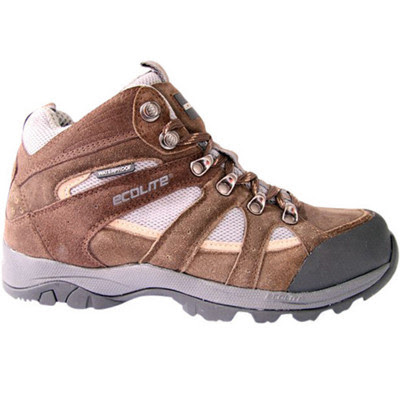Which shoes should I buy?
Without a doubt shoes are one of the most important pieces of equipment used while hiking. A good hiking shoe can mean the difference between an enjoyable weekend on the trails or a 48 hour nightmare of bruised feet, blisters and sore ankles. The following information is intended to be a simple guide to help people looking to start hiking pick the shoes most suitable for their needs.
Light Hiking shoes
Light hiking shoes often resemble a heavy duty running shoe. These shoes are usually low cut with plenty of arch support and a durable sole. These shoes are targeted at hikers looking for a sturdy shoe for use on short trips and day hikes. Due to the low weight of these shoes they are favored by ultralight hiking enthusiasts who are undertaking multi-day treks, though often prove unsuitable for prolonged travel for hikers carrying large, heavy loads due to their lack of extensive ankle protection and shock absorbent cushioning. Some light hikers have removable insoles allowing the wearer to replace or customize the shoes inserts. |
| An example of a light hiking shoe. These low cut shoes are generally more suited for hiking than tradition running shoes |
Hiking Boots
Hiking boots are the next step up from light hiking shoes. These boot provide decent ankle protection with a mid to high cut, plenty of padding under the heels, and generous arch support making them considerably more suitable for multi-day hikes while wearing a fully loaded pack. Most hiking boots are water resistant to some extent allowing travel in a multitude of weather and terrain conditions. Although these boots have several benefits over light hiking shoes they generally weigh more and require extensive wear before the shoes are broken in. | ||
| A more serious hiking boot by Ecolite featuring a mid cut, waterproof leather and goretex construction and extensive cushioning under the heal and arch of the foot. |
Backpacking Boots
These boots usually feature a high cut to support and protect the ankle from rolling or spraining while carrying heavy loads on uneven terrain. They also utilise goretex or leather to provide a waterproof construction and include extensive padding under the heals and support for the arch of the foot. These shoes are quite heavy, but are seriously durable and are suited for trips on and off trail. |
| A high cut backpacking boot constructed from leather and synthetic materials with design focusing on ankle protection and plenty of padding and support under the heal and arch of the foot |
Mountaineering Boots
These weightier boots with stiff midsoles are designed to accommodate heavy loads and accept crampons for glacier travel. Besides the usual benefits of hiking boots such as substantial heel padding and arch support, these hiking boots generally have a high cut providing the best ankle protection of all four major shoe types. Due to the design of mountaineering boots they are generally the best shoes for carrying loads above 20 kilograms in weight (40+ pounds) and often feature an insulating layer to keep feet warm in cold climates. |
| An example of a mountaineering boot designed to accept crampons and aid in carrying heavy loads |
For a more extensive guide on shoe selection please see the REI website at: http://www.rei.com/learn/expert-advice/hiking-boots.html
For additional information on hiking boots please see: http://en.wikipedia.org/wiki/Hiking_boot
The above information was written from information sourced from the above websites, hiking articles and my own personal experiences. I strive for 100% factual content, if anything in this article is incorrect please contact me so I may adjust the information accordingly.
No comments:
Post a Comment